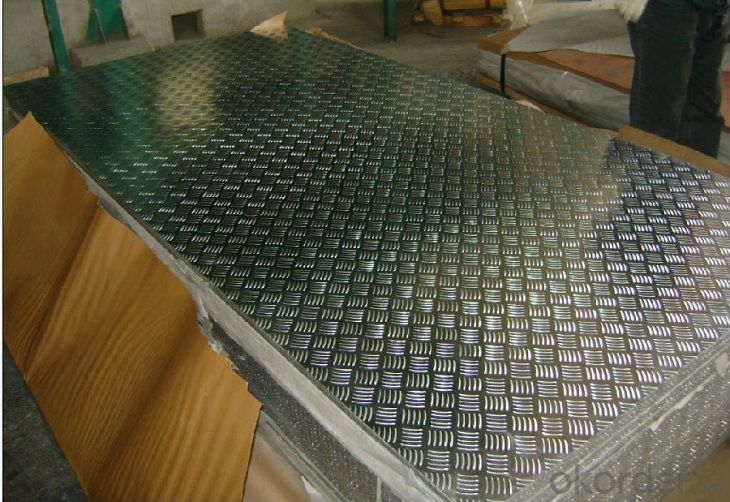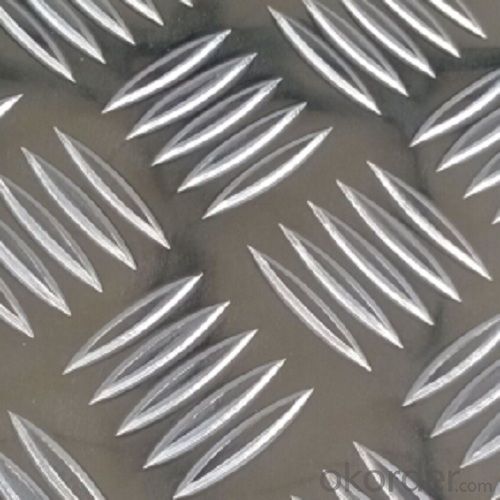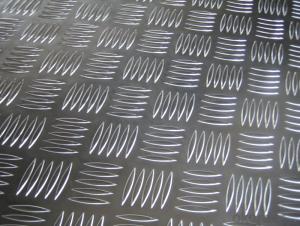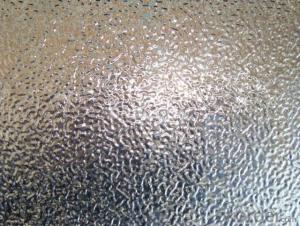Sheets Aluminum - Aluminium Stair Checker Plate 3003 H14 Thickness 2.5mm
- Loading Port:
- Shanghai
- Payment Terms:
- TT OR LC
- Min Order Qty:
- 2.5
- Supply Capability:
- 5000 m.t./month
OKorder Service Pledge
OKorder Financial Service
You Might Also Like
Specification
Aluminium Stair Checker Plate 3003 H14 Thickness 2.5mm
l Product Information:
1) Alloy: 1050, 1200, 1100,, 3003, 5052, 5754
2) Temper: H111, H112, O, H14, H24, H32
3) Thickness: 0.8mm to 10mm
4) Width: 100mm to 2300mm, Length: up to 11 Meter,
5) Patterns:Two bar, three bar, Five bar and diamond plate
6) Use: Refrigeration floor, Truck floor, flooring, stairs, indoor and outdoor decoration
l Packaging & Delivery
Packaging detail: Standard seaworthy exporting carton, Wooden pallets, waterproof paper and plastic coverage or as customer's requirement
Delivery detail: about 20 days from received oiginal L/C or advance payment

l Company Profile
CNBM International Corporation, China National Building Materials (Group) Corporation, is one of the largest companies in China building material & equipment industry, with 42,800 employees and sales in 2005 of US Dollar 4.395 billion. In 2006, China National Building Material Company Limited was listed on Hong Kong Stock Market with the stock code as 3323. |

l CNBM World Wide

l Product Images


l Certificates



l FAQ
Q: Do you provide free samples?
A: Yes, free samples will be sent to you on freight at destination.
Q: Can I get your latest products catalogue?
A: Yes, it will be sent to you in no time.
Q: What is the MOQ?
A: 2.5 tons
Q: What are your payment terms?
A: We accept L/C, T/T.
- Q: If one were to hit someone with a baseball bat, would it cause more pain to use a wooden bat or an aluminum one? Just wondering.
- The aluminum will hurt more with the reverberation that travels through the bat. Hence you see the rubber padding on the bat, along with wearing batting gloves. Would also sends some strong vibrations through the hands when the ball is struck in certain positions, however, catch a tough pitch with that aluminum without a batting glove and your hands will be stinging.
- Q: on an hot day, which will stay cooler longer...aluminum, or copper? why?thanks!
- Aluminum conducts heat faster than copper, so if both are left in the sun, the copper will stay cooler longer. When they are removed from the sunlight, the aluminum will become cooler first.
- Q: Can aluminum sheets be used for outdoor applications?
- Yes, aluminum sheets can be used for outdoor applications. Aluminum is a highly durable and corrosion-resistant material, making it suitable for various outdoor uses such as roofing, siding, and decorative cladding. It is also lightweight, which makes it easier to handle and install. Additionally, aluminum can be coated or painted to enhance its weather resistance and aesthetics, further increasing its suitability for outdoor applications.
- Q: Can aluminum sheets be anodized with custom designs?
- Yes, aluminum sheets can be anodized with custom designs. Anodizing is an electrochemical process that enhances the natural oxide layer on the surface of aluminum, making it more durable and corrosion-resistant. During this process, different patterns and designs can be added to the aluminum sheet by masking off certain areas and exposing others to the anodizing solution. This allows for custom designs to be etched or dyed onto the surface, creating unique and personalized finishes. Anodized aluminum sheets with custom designs are commonly used in various industries, including architecture, automotive, and electronics, to achieve aesthetic and functional requirements.
- Q: How does the thickness of aluminum sheet affect its strength?
- The thickness of an aluminum sheet directly affects its strength. Generally, thicker sheets tend to be stronger and more rigid due to the increased amount of material present. Thicker sheets are capable of withstanding higher loads and are less prone to bending or deformation under stress. However, it is important to note that other factors such as alloy composition and processing techniques also play a significant role in determining the overall strength of an aluminum sheet.
- Q: Can aluminum sheets handle high temperatures?
- Certainly! High temperatures are well-tolerated by aluminum sheets. With a melting point of 660 degrees Celsius (1220 degrees Fahrenheit), aluminum proves itself suitable for various applications requiring elevated temperatures. Furthermore, aluminum possesses exceptional thermal conductivity, enabling rapid heat dissipation. This attribute renders aluminum sheets ideal for deployment in environments necessitating resistance against high temperatures, including engine components, heat exchangers, and oven linings. Nevertheless, it is crucial to take into account the specific alloy and thickness of the aluminum sheet, as different alloys may impose different temperature thresholds.
- Q: Is it possible to apply paint to an aluminum sheet roof after it has been installed?
- <p>Yes, you can paint your aluminum sheet roof after installation. However, it's crucial to ensure the surface is clean and free of any contaminants. Use a primer specifically designed for aluminum to enhance adhesion and durability. Apply a high-quality paint suitable for metal surfaces, following the manufacturer's instructions carefully. This process can help protect the roof from weathering and enhance its appearance, but it's recommended to consult with a professional to ensure the best results and longevity of the paint job.</p>
- Q: Are aluminum sheets suitable for heat exchangers?
- Yes, aluminum sheets are suitable for heat exchangers. Aluminum is a lightweight and highly conductive material that allows for efficient heat transfer, making it ideal for heat exchanger applications. Its corrosion resistance also ensures the longevity and durability of the heat exchanger in diverse operating conditions.
- Q: Can aluminum sheets be bent or formed?
- Yes, aluminum sheets can be bent or formed. Aluminum is a highly malleable and ductile metal, which means it can easily be shaped or bent without breaking. This characteristic makes it a popular choice for various applications, such as manufacturing automotive parts, aircraft structures, and household items. Aluminum sheets can be bent or formed using various techniques, such as press braking, roll bending, and stretch forming. These methods allow the aluminum sheets to be shaped into different angles or curves to meet specific design requirements.
- Q: Can aluminum sheets be anodized for added durability?
- Indeed, it is possible to anodize aluminum sheets in order to enhance their durability. Anodization involves an electrochemical procedure that generates a protective oxide layer on the aluminum surface. This layer not only improves the material's appearance, but also boosts its ability to resist corrosion, wear, and scratches. By undergoing anodization, aluminum sheets acquire a robust, long-lasting finish, rendering them highly suitable for a range of applications that necessitate durability, including construction, automotive, aerospace, and electronics industries. Moreover, anodized aluminum sheets can be dyed in various colors, enabling them to exhibit enhanced aesthetic appeal while retaining their durability.
Send your message to us
Sheets Aluminum - Aluminium Stair Checker Plate 3003 H14 Thickness 2.5mm
- Loading Port:
- Shanghai
- Payment Terms:
- TT OR LC
- Min Order Qty:
- 2.5
- Supply Capability:
- 5000 m.t./month
OKorder Service Pledge
OKorder Financial Service
Similar products
Hot products
Hot Searches
Related keywords




























